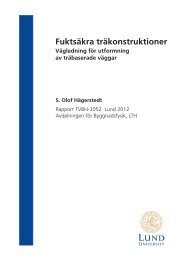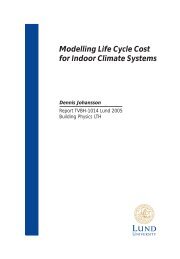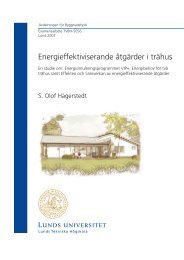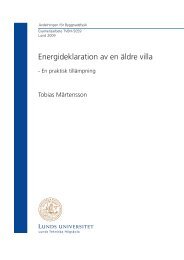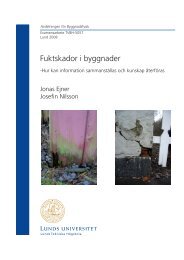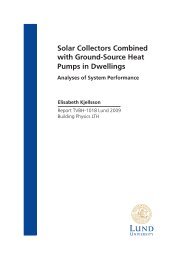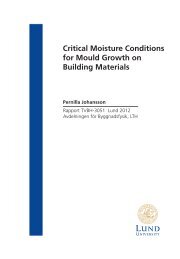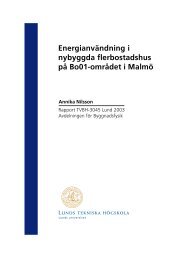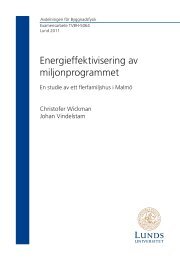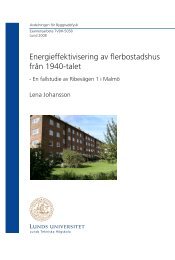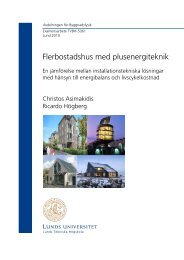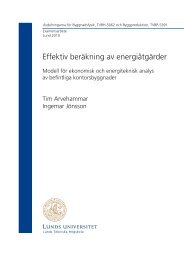TVBH-5054 - Byggnadsfysik - Lunds tekniska högskola
TVBH-5054 - Byggnadsfysik - Lunds tekniska högskola
TVBH-5054 - Byggnadsfysik - Lunds tekniska högskola
Create successful ePaper yourself
Turn your PDF publications into a flip-book with our unique Google optimized e-Paper software.
Summary<br />
Title: The drying rate of exterior walls of a wet room<br />
- A comparishon between three architectonical solutions<br />
Authors: Karin Grimbe and Linnéa Nordqvist<br />
Supervisor: Lars-Erik Harderup<br />
Department of Building Physics<br />
Lund Institute of Technology, University of Lund<br />
Complex of<br />
problem:<br />
The costs of moisture damages ought to be reduced by increasing the<br />
amount of time spent on moisture dimensioning. Moisture dimensioning<br />
results in architectonical solutions that consider an unexpected moisture<br />
load, for example damage caused by leakage and exposure to excess<br />
moisture from the production phase. The costs of these damages should<br />
be reduced by the use of more forgiving architectonical solutions. The<br />
question this report attempts to answer is: “Does the architectonical<br />
solution with the vapour retarder Halotex D50 work satisfactorily as a<br />
more forgiving solution than the conventional solution with or without a<br />
polyethylene vapour barrier?”<br />
Purpose: The main purpose of this study is to investigate differences concerning<br />
the forgiving qualities, drying rate and utility for three different<br />
constructions of light-weight wet room exterior walls. The study also<br />
investigates the profits and drawbacks of installing the Honeywell HIH-<br />
3610-002 humidity sensor in the walls.<br />
Method: The drying rate of gypsum board in three different wet room exterior<br />
wall constructions evaluates. In a laboratory the drying rate is measured<br />
in a full-scale wall using humidity sensors placed inside the<br />
construction. Corresponding simulations were also performed in the<br />
computer program 1D-HAM.<br />
Conclusions: A comparison of the three wall constructions shows that the wall with<br />
the vapour retarder performs in between the two other constructions. The<br />
construction with the vapour retarder is more forgiving in order to allow<br />
wet materials to dry out quicker compared to the wall with the<br />
polyethylene layer. The vapour retarder is also more user-friendly than a<br />
wall without a vapour barrier. A wet room exterior wall with a vapour<br />
retarder works well as a forgiving alternative to the traditional<br />
architectonical solutions with or without a vapour barrier.<br />
IV<br />
The computer program 1D-HAM, which is used for additional drying<br />
simulations, does not yield satisfactorily results. The program disregards<br />
several parameters and it is questionable to whether or not it is<br />
applicable to this kind of wall. The program is to be considered as a<br />
guide. The result indicates how the drying of the walls appears to be, and<br />
can be used to compare the relative drying rates of the different wall<br />
designs in different climates. Since the program does not handle<br />
temperature and moisture dependencies in the input data, the reliability



